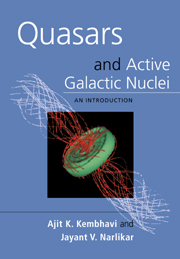Book contents
- Frontmatter
- Contents
- Preface
- Acknowledgments
- Acronyms and abbreviations
- 1 HISTORICAL BACKGROUND
- 2 THE COSMOLOGICAL FRAMEWORK
- 3 RADIATIVE PROCESSES–I
- 4 RADIATIVE PROCESSES–II
- 5 THE STANDARD MODEL
- 6 SURVEYS
- 7 LUMINOSITY FUNCTIONS
- 8 THE CONTINUUM
- 9 RADIO PROPERTIES
- 10 X-RAY EMISSION
- 11 X-RAY AND GAMMA-RAY SPECTRA
- 12 UNIFICATION
- 13 QUASAR ABSORPTION LINES
- 14 GRAVITATIONAL LENSING
- 15 PROBLEMS AND CONTROVERSIES
- References
- Books, reviews and proceedings
- Author index
- Subject index
7 - LUMINOSITY FUNCTIONS
Published online by Cambridge University Press: 05 June 2012
- Frontmatter
- Contents
- Preface
- Acknowledgments
- Acronyms and abbreviations
- 1 HISTORICAL BACKGROUND
- 2 THE COSMOLOGICAL FRAMEWORK
- 3 RADIATIVE PROCESSES–I
- 4 RADIATIVE PROCESSES–II
- 5 THE STANDARD MODEL
- 6 SURVEYS
- 7 LUMINOSITY FUNCTIONS
- 8 THE CONTINUUM
- 9 RADIO PROPERTIES
- 10 X-RAY EMISSION
- 11 X-RAY AND GAMMA-RAY SPECTRA
- 12 UNIFICATION
- 13 QUASAR ABSORPTION LINES
- 14 GRAVITATIONAL LENSING
- 15 PROBLEMS AND CONTROVERSIES
- References
- Books, reviews and proceedings
- Author index
- Subject index
Summary
Introduction
The luminosity function of a population of discrete sources describes the distribution of the objects in space as a function of their luminosity. Apart from luminosity, such a function may depend on many other properties, the environment and the evolutionary state of the universe. Surveys for a particular kind of object provide the surface density of the objects in the sky as a function of their magnitude, redshift and perhaps some other attributes. Using redshift as the distance indicator, the surface density can be deprojected to provide their number per unit volume of space, which is the more fundamental quantity. Owing to the limited data available, the deprojection involves a number of techniques, assumptions and models, some of which we will describe below.
The space density of quasars is a fundamental quantity because it could help link the quasar phenomenon to other objects, such normal galaxies, in the universe. On the one hand, the properties of quasars are very similar to those of the active galactic nuclei (AGN) of Seyfert galaxies and radio galaxies. On the other hand, nebulosities which resemble galaxies have been discovered around some low redshift quasars (see Chapter 8). Given these two facts, it is generally believed that quasars represent the extreme end of the active galaxies population, in which the luminosity of the active nucleus overwhelms the luminosity of the rest of the galaxy. Active galaxies similarly are considered to be an extreme subset of all galaxies. From the space density of the different kinds of active objects it will be possible to determine whether this is indeed the correct picture.
- Type
- Chapter
- Information
- Quasars and Active Galactic NucleiAn Introduction, pp. 152 - 182Publisher: Cambridge University PressPrint publication year: 1999



